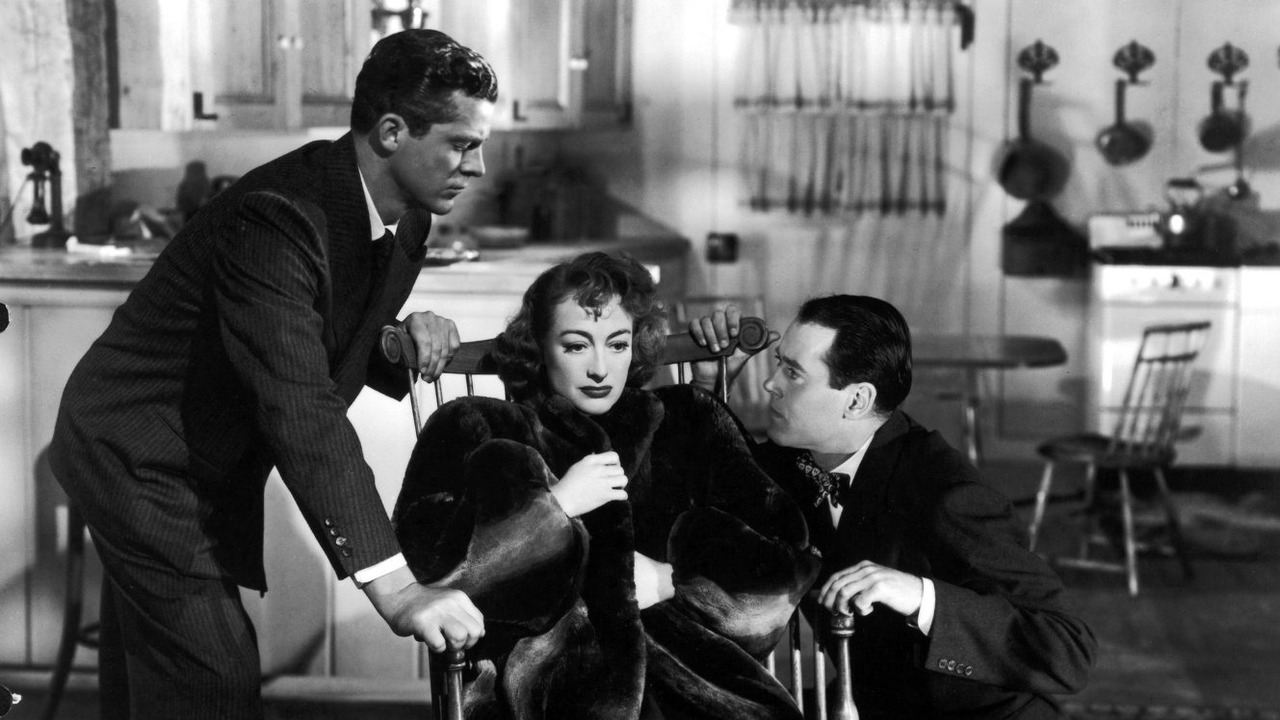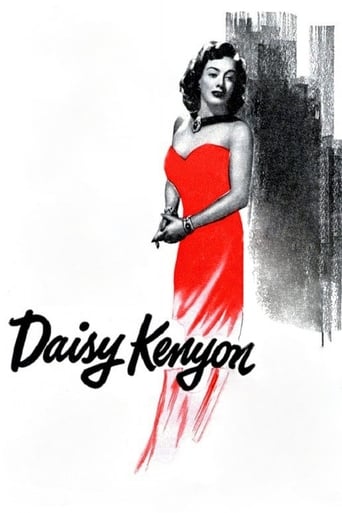

You won't be disappointed!
... View MoreThis is a coming of age storyline that you've seen in one form or another for decades. It takes a truly unique voice to make yet another one worth watching.
... View MoreIf you're interested in the topic at hand, you should just watch it and judge yourself because the reviews have gone very biased by people that didn't even watch it and just hate (or love) the creator. I liked it, it was well written, narrated, and directed and it was about a topic that interests me.
... View MoreThis movie tries so hard to be funny, yet it falls flat every time. Just another example of recycled ideas repackaged with women in an attempt to appeal to a certain audience.
... View MoreCaught this recently on the Movie Channel and despite the 1000 interruptions, really enjoyed it. Whoever said this is not Film Noir needs to think again. Film noir refers to a style marked by a mood of pessimism, fatalism, and menace. All three permeate Daisy Kenyon. The term was originally applied (by a group of French critics) to American thriller or detective films made in the period 1944–54 and to the work of directors such as Orson Welles, Fritz Lang, and Billy Wilder. David Thomson spoke on this - he cited Mildred Pierce as his favorite Film Noir. But you say - "where's the crime? where's the mystery?" The crimes are Crimes of the Heart, what the Catholic Legion of Decency used to label "objectionable in part for all", which was code for extramarital affairs, men deserting their children, women marrying for security vs love and getting hooked on married men who string them along for years - in short LIFE as Otto Preminger dared to show it in 1947. The mystery is how Daisy has the most courage of anyone in the film - despite her societal status as "damaged goods". Despite the complaints I've read about the casting - I thought it was excellent. Dana Andrews does a beautiful transition from a total cad and later the much sadder but wiser man. Henry Fonda is quite a mystery himself - and what a delight. And Joan Crawford does a spectacular job as a fallen woman of integrity, trying to swim with the barracudas.
... View MoreI'm not referring to the title character, played by the heavily shoulder padded Joan Crawford. I am referring to the embittered wife (Ruth Warrick) of the man (Dana Andrews) that Crawford is in love with. Warrick is an obviously bi-polared woman who shows no love for their two daughters who prefer the love of their much absent father. Warrick is determined to keep her paws on her husband, even if the marriage is miserable. We've seen this type of woman on screen many times, most notably to me Kay Francis in "In Name Only", Barbara O'Neill in "All This and Heaven Too", and most nastily, Constance Ford in "A Summer Place". These characters aren't one dimensional, they are just women who should have remained single (or questioned their sexuality), and prove that not all women should become mothers. Controlling, snobby (not unlike her role of Phoebe on "All My Children") and even somewhat abusive, Warrick is also conflicted inside, and the script gives the impression that she needs a ton of therapy if she is going to have any type of loving relationship with her children and some sort of communication with Andrews.This plot line is nothing spectacular, but with director Otto Preminger at the helm, a lot of psychology is inserted to explore the four miserable adult characters. That also includes Henry Fonda as a recently returned soldier who ends up marrying Crawford on the rebound. Lacking chemistry, Fonda and Crawford seem more like brother and sister than marital partners. It is ironic that Fonda would share chemistry with the three other dramatic divas of the golden age of cinema (Bette Davis, Barbara Stanwyck and Katharine Hepburn), but has absolutely none with Crawford. She looks more masculine here even than she did as "Mildred Pierce". This is the type of film she did better in the 1930's, as the film does not suit the changes in America after World War II ended.
... View MoreElizabeth Janeway's novel becomes depressive soap in the usually-capable hands of director Otto Preminger. Had Preminger not also served as the film's producer, I might guess this melodrama was foisted upon him as a contractual obligation (it certainly doesn't seem like material he'd be attracted to). New York artist Joan Crawford, living in a rather elaborate 'hovel', marries ex-soldier and widower Henry Fonda as a response to lover Dana Andrews constantly putting his wife, children and business affairs before her. It is apparent that Andrews and Crawford are having a sexual relationship, yet Joan doesn't act like a fallen woman; she strides about during an argument, cleaning up her apartment defensively until Dana takes her in his arms (where she melts, like a pushover). Fonda and Crawford do seem like the better match (he calls her "Deezy" and she calls him "Peetah"), but the circles these stuck-in-a-rut characters go around in quickly become tiresome. Preminger doesn't have many surprises in store for us (except Andrews' scorned wife, who takes her frustrations out on her youngest daughter), although Andrews' penchant for using terms of endearment towards both women and men is amusing, and the design here is tidy and attractive. **1/2 from ****
... View MoreThis film is a great vehicle for Joan Crawford, and one of my favorites from the middle portion of Joan's career . In fact, I can't imagine any other actress in the lead. Daisy Kenyon (Joan Crawford) plays a commercial artist who is the strong independent type. She has fallen in love with a married man of means (Dana Andrews) who has a clingy and emotionally unstable wife (Ruth Warrick) and a couple of daughters that he knows he will lose access to if he gets a divorce. In other words, he is permanently married and he and Daisy's relationship is going nowhere. Enter Peter Lapham (Henry Fonda), a widower recently back from World War II. Both men love Daisy, but only one can "do right" by her - Peter. Unfortunately, he is not the man she loves.The resulting love triangle, the idea of any of this being particularly scandalous even to someone aiming for public life, and in particular the then quite backwards divorce laws of the state of New York might seem quaint to a modern audience, but the private situations and emotions of the characters still ring true. Who does Daisy choose in the end? The man willing to give her up. I'll let you watch the film and find out which of the two men that is.
... View More